How to Read Your Dog Body Language
Reviewed for accurateness on December 12, 2019, by Dr. Wailani Sung, MS, PhD, DVM, DACVB
Dogs limited their emotions with their bodies, just nosotros're not ever able to correctly interpret the messages they're sending. Or worse yet, we misunderstand their intent, which tin can brand a challenging state of affairs fifty-fifty worse.
Learning to read what your dog is communicating is one of the most important things you lot tin do to strengthen your relationship with them. While every canis familiaris will have their own unique nuances to their communication style, most dogs rely on like postures to convey how they're feeling.
When reading a canis familiaris's body language, it'due south important to annotation that the dog's entire body plays a role in signaling; for example, a wagging tail doesn't necessarily mean that a domestic dog is happy, specially if the rest of their trunk is stiff.
Everything from your canis familiaris'southward ears and expression on their face to the placement of their feet, and of class, the tail, piece of work together to help communicate your dog'due south emotional state.
Here are some dog trunk linguistic communication basics to assist yous sympathize what your canis familiaris is trying to tell you.
Happy Dog Torso Language
A happy dog is engaged in their surroundings and will take a loose, waggy posture.
-
Ears: Held in their natural position; pointed ears will stand direct, and floppy ears will hang slightly frontwards
-
Eyes: Soft, and the brow is neutral (without wrinkles)
-
Rima oris: Either closed without tension around the lips, or if the dog is active, open in a relaxed pant
-
Tail: Wagging in a wide, sweeping motion that is even with the spine, or if the canis familiaris is engaged in play, wagging slightly higher
The overall body posture will be soft and wiggly, and some of the dog's movements might be overexaggerated, especially during play.
Examples of Happy Dog Trunk Language:
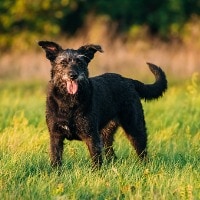

Alert Dog Body Linguistic communication
An warning dog is assessing his surroundings for more than data.
-
Ears: Perked up and pointed forwards (look at the base of operations of the ear for floppy ear breeds)
-
Eyes: Wide open up and focused with a neutral, relaxed forehead
-
Mouth: Closed without tension at the lips or effectually the snout
-
Tail: Extended from the body, even with the spine and possibly wagging slightly
The dog'due south overall body posture is distributed evenly between the four feet in a "ready" position every bit they determine their next steps. Below are examples
Examples of Alert Domestic dog Body Language:

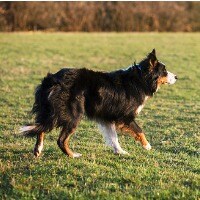
Stressed or Nervous Dog Trunk Linguistic communication
A domestic dog that'south stressed or uncomfortable will exhibit many of the same postures as a nervous dog but might likewise perform a series of behaviors called "calming signals."
These movements are appeasement or deportation behaviors that represent an attempt to self-calm or reduce escalating tension.
Calming signals include:
-
Looking away
-
Turning away
-
Moving in a curve
-
Slow movements
-
Yawning
-
Freezing
-
Lip licking
-
Lip smacking
-
Sniffing the ground
-
Raising one paw
-
Scratching
-
Shaking off (like later getting wet)
Stressed dogs often avoid centre contact or await at the trigger, then apace look away.
A distressed dog might perform exaggerated yawns, sneeze or lick their lips frequently. They might besides shake their bodies as if their coat is wet, focus on cocky-grooming, or scratch themselves excessively.
Examples of Stressed or Nervous Dog Trunk Language:
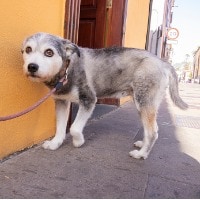
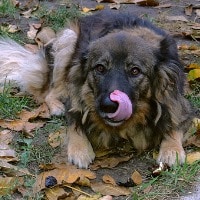
Fearful Dog Body Language
A nervous or fearful domestic dog will take a stiff posture and might hunch over so that their back is curved and their head is shut to the footing.
-
Ears: Tucked back confronting the head
-
Eyes: The canis familiaris might turn their head abroad from a stressor but angle their optics towards information technology, causing the whites of their eyes to show (referred to as "whale eyes").
-
Mouth: The dog might go along their mouth tightly closed with the corners of the mouth pulled back, or they might begin panting without a temperature change or increment in activity.
-
Tail: A nervous canis familiaris volition constrict their tail and then that it's pressed upward confronting the belly, and they will distribute their weight and then that they are shifted back and away from potential triggers.
The dog's overall trunk posture is stiff and low, and they might shed more readily when nervous.
Example of Fearful Domestic dog Torso Language:

Submissive Dog Body Language
A submissive dog tries to appear modest and every bit less of a threat. They might lower their body to the ground, or even flip over on their back to betrayal their stomach.
-
Ears: Pinned back
-
Eyes: A submissive domestic dog will avoid middle contact and squint their optics.
-
Mouth: There will exist tension around the mouth, and the dog might pull back their lips to expose their front teeth in a "submissive smiling," which looks similar a smile, but is a manner of showing deference. The domestic dog might also lick effectually their muzzle frequently.
-
Tail: Tucked or held low and moving in a slow, tight wag
The canis familiaris might also heighten a front mitt in an appeasement gesture. Their overall movement is boring, and their weight will exist shifted backwards to appear less threatening.
Case of Submissive Canis familiaris Torso Language:
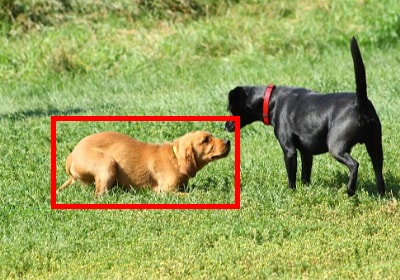
Ambitious Dog Body Language
An aggressive canis familiaris is prepare to react to a stressor.
-
Ears: Depending on the reason for a domestic dog'due south aggression, they will hold their ears differently. So this is a scenario where information technology's essential to have a dog's whole body positioning into account.
-
A fearful domestic dog will typically hold their ears back and against their head.
-
An assertive, confident dog will prick their ears forwards or to the side.
-
-
Eyes: Their gaze will be stock-still on the stimulus with a hard, unwavering stare, with wrinkles beyond the forehead.
-
Mouth: There is tension effectually the mouth, and the dog might besides take wrinkles across the cage or a raised upper lip, exposing the teeth.
-
Tail: Again, yous will demand to accept a domestic dog's whole body into business relationship here.
-
A fearful domestic dog may concur their tail depression or tucked before an act of a assailment but heighten it during the human activity.
-
A confident dog may hold their tail loftier to a higher place their torso and it will possibly exist twitching from side to side in a tight wag.
-
The fur might exist raised forth the spine in piloerection (likewise normally referred to as their hackles), specially across the shoulders and at the base of the spine near the tail.
The domestic dog'southward weight will be shifted forward in a stiff-legged "ready" opinion.
An aggressive dog's overall body posture is rigid and tense, with minimal movement.
Examples of Aggressive and Confident Canis familiaris Trunk Language:


Past: Victoria Schade, Pet Grooming and Behavior Specialist
Featured Image: iStock.com/skyenesher
Source: https://www.petmd.com/dog/puppycenter/communication/evr_dg_visual_communication
0 Response to "How to Read Your Dog Body Language"
Post a Comment